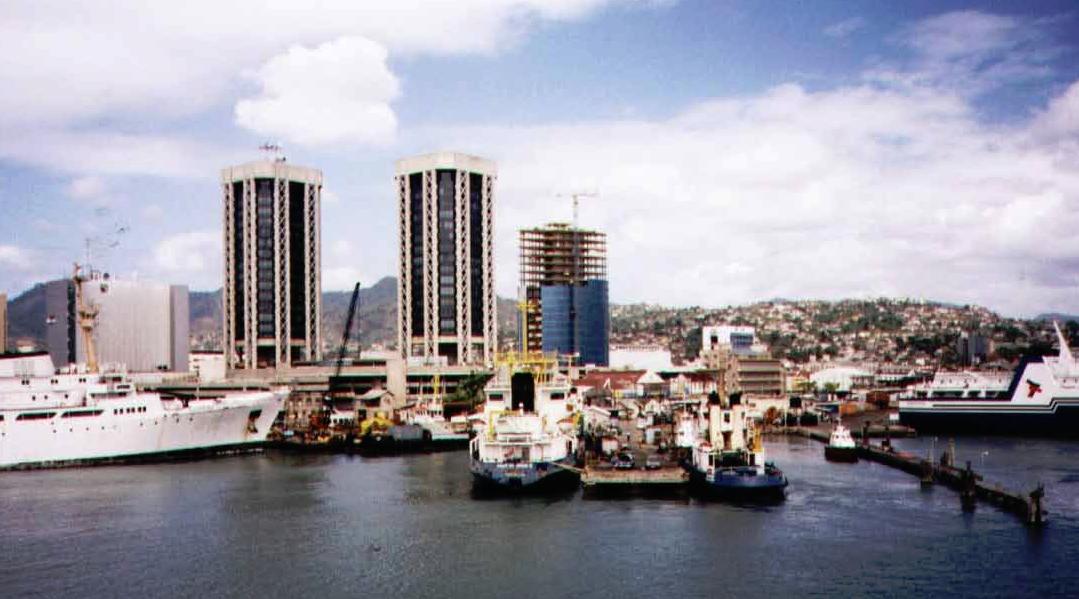
Cruise ships are important to the economies of Caribbean islands, but the Port Authority in Trinidad & Tobago has seen a huge growth in cargo in recent years, as Jeff Daniel discovers.
For those of us yet to enjoy a Caribbean visit, Trinidad & Tobago are right at the bottom of the chain of islands that make up the West Indies, almost within hailing distance of South America; at certain points the seas between Trinidad and Venezuela divide the two nations by no more than about seven miles.
Not surprisingly, the country has an economy that owes a great deal to tourism and in particular to cruising. And where you have cruise ships, you have to have an efficient port to cater for the ships and currency-carrying passengers.
Port of Spain—the principal city in Trinidad—is tucked behind a protective peninsula, sheltered from adverse weather coming either from the Gulf or the Atlantic. It’s an ideal haven for shipping, making it the obvious choice for the island’s major port, tautologically known as Port of Port of Spain.
For the first 25 years of its existence, since the Port Authority was created by act of parliament in 1962, the port grew steadily but in the 1980s really began to take off, first calling for a doubling of working shifts and then in the late 1990s, a round-the-clock working pattern.
In the 1990s, the Port Authority initiated a program of restructuring. Under the guidance and coordination of a transition team, each of three separate parts of the business created its own development team charged with the responsibility for organizing the formal side of setting up independent business units. This culminated in the creation of three new companies: Port of Port of Spain, Trinidad and Tobago Inter Island Transport and Port of Spain Infrastructure Company.
The Port Authority appointed Portia Management Services (the international consultancy arm of Mersey Docks and Harbor Company) in 2006 to oversee development of the port facilities. Portia is the UK's longest established and most successful port management and consultancy organization with over 200 projects under its belt in Africa, South America and India. It has three main areas of interest: consultancy, management and investment.
To give an indication of the scale of growth, in 1990 only 507 cargo vessel calls were recorded at the Port of Port of Spain, while nine years later, there were 1,294—a growth of over 150 percent—or around seven cargo vessels berthing every couple of days.
These days, approximately 90 percent of all cargo handled is in the form of containers. The second most important cargo comes under the heading of dry/liquid bulk, accounting for around 8 percent of the total and the balance coming from break-bulk cargo. Interestingly, this latter segment, while only a quarter the tonnage of bulk freight, contributes significantly more to overall revenue than dry/liquid bulk operations.
The Port of Port of Spain has established itself as the major general cargo port in Trinidad & Tobago, handling approximately four fifths of containerized cargo coming into the country. Add all facets of container operations together, in other words imports, exports and transshipment, and the Port saw average annual growth in the 90s of over 20 percent, taking the volume as measured in twenty foot equivalent units (TEUs) from 58,427 TEUs in 1990 to 271,156 TEUs a decade later. Imports and exports are roughly equal in importance by tonnage but by far the largest contribution to revenue comes from transshipment business—equal in size to the other two sectors put together.
The Port of Port of Spain has also experienced good growth in international cruise shipping over the last decade and this growth can be attributed to the joint efforts of the Trinidad and Tobago Industrial Development Corporation and the Port Authority in their overseas marketing of Trinidad and Tobago as cruise destinations. The Port has a dedicated passenger terminal at the Cruise Ship Complex in Port of Spain. As well as the single dedicated berth, one of its three general purpose berths can also be used for handling additional cruise vessels, if necessary.
There is a considerable variety in the scope of vessels visiting Trinidad from boutique liners carrying no more than 90 passengers in stateroom luxury accommodation to cruisers capable of taking over 3,000 passengers at a time to the sun.
It shouldn’t be forgotten that we are talking about a country that comprises two islands. The Port Authority manages a sister harbor in Tobago in the deep water harbor of Scarborough. The original name for Tobago gave birth to the word tobacco and some say that the story of Robinson Crusoe was inspired by the island. It is certainly true that a Walt Disney film based on the book was shot there and that eco-tourism is now big business.
Tobago was first settled by Europeans from Latvia in 1654 and then changed hands 33 times as one colonial power after another took possession. In 1814 it became part of the British Empire and was twinned with Trinidad in 1889. Scarborough is linked with Port of Spain by a high speed ferry and visitors can get a different view of the country by taking an US$8 ferry ride over the 150km separating the two harbors.
The third stream of revenue for the Port Authority comes from the management of the 155 hectares of land it owns on both islands. It is one of the largest single real estate owners in Trinidad. Approximately one third of its land in Port of Spain is dedicated to port operations. The remaining land is leased out to tenants for various periods from as short as monthly rentals to 30-year leases. Major tenants are National Petroleum Marketing Company, National Flour Mills, National Fisheries, Trinidad and Tobago Electricity Commission and the Customs and Excise Department’s Container Examination Station. The Authority also obtains revenue from the lease of the cruise ship terminal facilities in Port of Spain and Scarborough.













